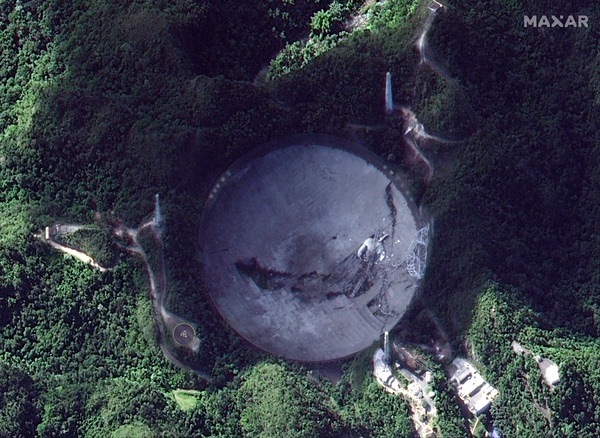Arecibo telescope’s fall is indicative of global divide around funding science infrastructureby Raquel Velho
|
| I see what happened at Arecibo as a classic example of the tension between facility maintenance and scientific progress. |
But for all its achievements, US commitment to Arecibo began to falter in 2006. The National Science Foundation (NSF), which supported Arecibo, implemented a 15% budget cut that year across its Division of Astronomical Sciences. Arecibo was among the first facilities on the chopping block, despite its continued productivity.
The previous year, the NSF had announced it was preparing to reallocate funds between existing facilities in order to initiate “new activities.” These initiatives included the funding and development of the Atacama Large Millimeter Array in Chile, starting in 2003.
The decision to cut Arecibo’s funding was met with resistance from the scientific community and beyond, including the then-governor of Puerto Rico, Aníbal Acevedo Vilá, who wrote to the NSF requesting reconsideration.
But in 2007 Arecibo’s budget was slashed from $10.5 to $8 million. With a second major cut scheduled for four years later, the closure of the facility seemed imminent. Instead, the NSF tasked a new consortium to take over the management of Arecibo in 2011, changing it from a federally funded institution to one that could seek funds from other sources.
Optimism about this development soon gave way to pessimism. NSF continued to support Arecibo, with NASA pitching in a third of costs. However, the balancing act of a flat NSF budget and the promise of other new observatory projects once again threatened the observatory. In 2015, Robert Kerr, then facilities director of Arecibo, quit, allegedly over funding clashes. In 2018, the University of Central Florida took over management of Arecibo and helped it recover from damages sustained by Hurricane Maria.
But the end was coming. On November 19, 2020, the NSF finally announced the official end of operations at the telescope.
Pride of place
A community of astronomers and locals are actively mourning the ruins of Arecibo. Beyond its scientific success, Arecibo signified more.
#WhatAreciboMeansToMe, a hashtag on Twitter, has collected hundreds of stories from locals and tourists, astronomers and enthusiasts alike. Puerto Rican voices are loud here, many recounting childhood memories of hiking up the trail to the Ángel Ramos Visitors’ Center.
| It is time to begin discussions beyond the scientific importance of research facilities. Planners must address their full life cycles and their impact on local communities. |
The Arecibo Observatory occupied a space of pride for Puerto Rican scientists and the local community. In many ways, it was a symbol of the island. Through this lens, to watch the Arecibo Observatory be allowed to collapse and become rubble is painful for many, especially when contrasted with defunct observatories in the continental United States, where a number are preserved as historical sites.
In Latin America, infrastructure projects are often tied to ideas about economic development—a potential answer to solve a country’s ills. In this context, to watch a prized facility literally crumble, as the United States retracted its financial involvement, seems like nothing less than abandonment.
It is interesting to note that controversy has often followed the construction of large astronomy facilities. From the Maunakea Observatories being built on land sacred to native Hawaiians to labor disputes in the building of the Atacama Large Millimeter Array in Chile, to the seizing of lands and racial tensions surrounding the Square Kilometer Array in the Karoo region of South Africa, a pattern emerges of Northern scientific institutions investing in regions with long colonial histories—and stirring up local concern and discontent.
In the case of Arecibo, these disputes flared at the end rather than at the beginning. But a similar lack of interest in how scientific research facilities fit the place they inhabit is clear. In my view, it is time to begin discussions beyond the scientific importance of research facilities. Planners must address their full life cycles and their impact on local communities.
Note: we are temporarily moderating all comments submitted to deal with a surge in spam.
